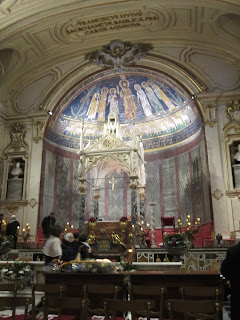Venerated as the patron saint of musicians, St. Cecilia is one of those many Romans who held steadfast to the faith in the persecutions against the Roman Church during its early years. She was a Roman maiden engaged to be married to a pagan named Valerian. After their marriage, she brought him to Pope Urban I. After meeting the pontiff, he had a vision which encouraged his subsequent conversion. He then prayed that his brother Tibertius would turn to the faith as well, which prayer was quickly answered. Cecilia played an important role in both conversions by the witness of her holy life and through the catechetical instruction she offered. The two brothers took up the task of burying the remains of the martyrs, in the course of which they attracted the suspicion of the Roman authorities. When confronted and ordered to sacrifice to a statue of Jupiter, they refused, and were beheaded for the faith. Cecilia was arrested next and condemned to suffocation in the bath of her house. This not harming her, she was condemned to be beheaded. After the executioner struck her three times, she was wounded but not killed. As Roman law forbade any more strikes of the ax, she was left to die of her wounds. For three days she persisted, continuing to encourage her fellow Christians in the faith and others to conversion. She finally was rewarded with the crown of martyrdom, after giving all her goods to the Church and asking Urban to turn her home into a place of worship.
From this triumph over her suffering, the history of the church dedicated in her honor begins. The remains of a structure from the late second century after Christ, believed to be the baths in which the patroness was killed, can be seen among other ruins beneath the church. In the second half of the fourth century, a structure believed to be a simple shrine in honor of the saint was built, and shortly thereafter became the seat of a titulus. Under Pope St. Paschal I, a basilica replaced this to serve as a more fitting place for the remains of the saint and her companions which were then translated from the catacombs of St. Callistus. Although the general lines of the church remain the same today, subsequent renovations have greatly altered its appearance. The medieval period left its mark on the church, with the campanile, porch, ciborium, and some interior frescoes remaining from this time. In 1527, a convent was attached to the church. It was likely around this time that the enclosed galleries above the aisles were added to allow the nuns to attend Mass without leaving the cloister. The façade of the church dates from about this time as well. The outer entrance to the courtyard was completed under Ferdinando Fuga in 1724, a year which also saw a general refurbishment of the interior and exterior of the basilica under its cardinal titular, Francesco Cardinal Acquaviva. The most recent major change to the interior was in 1824 when the columns in the nave were converted into pillars. In the early twentieth century, the crypt was renovated and the chapel before the tombs of the saints was redecorated.
Below the high altar is the artistic treasure of this church, the statue of the martyred patroness. When her tomb was last opened in 1599, the artist Stefano Maderno was present and saw her body in its incorrupt state. The next year he carved this statue which is now here above the body of the the saint beneath in the crypt. Her three outstretched fingers represent the Trinity. Although bearing the marks of her death on the neck, she nonetheless has a peaceful appearance as she rests in death.
 |
| The Tomb of St. Cecilia under the main altar |



No comments:
Post a Comment